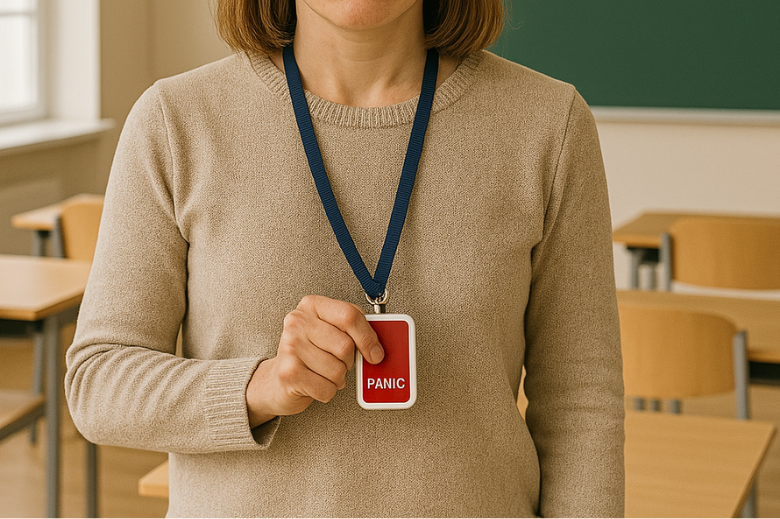Ah, the good ol’ days. Back when scraped knees were battle scars, bike rides were freedom, and mom had an arsenal of classic one-liners that could stop you in your tracks.
One of the best?
"Well, if everyone jumped off a bridge, does that mean you would too?"
You knew it was coming. Probably after you and your friends did something without considering the consequences—like attempting to ride your bikes down a hill at full speed with no brakes, just because Jimmy from down the street swore it was totally safe. (Spoiler: It wasn’t.)
But somehow, the logic of “everyone else is doing it” seemed airtight at the time. Until mom shattered it with that one sentence.
Fast forward to today, and while we may not be riding our bikes into disaster anymore, the same logic problem still applies—except now, it’s school districts jumping off the proverbial bridge.
The Panic Badge Bandwagon
There’s a trend sweeping across schools right now: panic badges.
One district picks up a certain brand, the news covers it, and suddenly every other district is scrambling to do the same. Because if it’s making headlines, it must be good, right?
But here’s the problem: just because it’s popular doesn’t mean it's the best solution to your problem.
Schools aren’t choosing panic badges based on real-world effectiveness. They’re choosing them because everyone else is using them. It’s a knee-jerk reaction, not a thoughtful decision about what will actually protect students and staff in a crisis.
And when the moment of truth comes—when a real emergency strikes—it’s too late.
Where does the panic button belong?
The K12 industry is hearing many messages about school safety, and one vendor is promoting that a panic badge is your “insurance policy” to safety. You are told that when the crisis starts, hit the panic button. When shots are fired, hit the panic button.
If the panic button is your only solution, pressing the button at this point is too late.
Here’s 5 things you should know about panic buttons that other vendors aren’t telling you:
- The panic button has its place, and in most cases, it’s after what we refer to as “bang”. This is derived from the “Left of Bang” methodology from the book “Left of Bang” by Patrick Van Horne and Jason A. Ryley. However, this is after the crisis has started, and trauma has been inflicted. The panic button is your last resort, or when all other means of preventing crisis have either been missed or were unavoidable.
- The panic button should not be your only solution. When looking at the 4 phases of emergency management (Preparation, Prevention/Mitigation, Response, Recovery), there’s tools (and skills!) for every phase that we should be equipping our schools with if safety is truly the #1 priority. Make sure you have a tipline system that ensures tips are addressed quickly, a visitor management system that can do real-time background checks, an alert system that allows for two-way communication for everyone, and a way to account for students in real-time. There’s plenty more, but this is still much better than “just” a panic button.
- Every person should have access to two-way communication. We’ve seen time and time again during violent incidences where, if staff members had a way to communicate during a crisis, it most likely would have changed the outcome. Be mindful of this when vendors tell you, “All you need to do is press this button, and you’ll get help.”
- You can operate a mobile app with ease. Some vendors will trick you into thinking that mobile apps are cumbersome, hard to navigate, and that you won’t have the dexterity to operate them during an emergency. This is a sales tactic to persuade you to believe that all you need is a panic button (consequently, the flagship solution they sell—hmm, interesting).
- Wi-Fi and Cellular can be reliable. You might hear the opposite from one vendor, but again, this is a sales tactic to get you to invest in their proprietary network. Most of your law-enforcement agencies use WiFi or Cellular, so why would you want another system to manage?
What Schools Should Be Doing
The answer isn’t in picking a panic badge just because it’s trending. It’s in making informed choices based on real safety measures—ones that hold up in high-stress, real-world scenarios.
A panic button that only shouts “something bad is happening” but can’t provide details isn’t enough. Schools need solutions that allow two-way communications for everyone, so teachers and staff can provide live updates to responders.
Schools also need preventative tools that let them quickly locate students, alert security teams, and take action before a situation escalates.
Because at the end of the day, our job isn’t to follow the crowd. It’s to protect the next generation.
And that starts with asking a better question than “Which badge is everyone else using?”
It starts with asking, “What will actually keep our schools safe?”
So, districts—before you jump off that bridge, maybe take a step back.
And choose wisely.









No Comments Yet
Let us know what you think